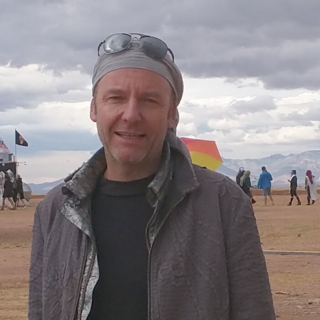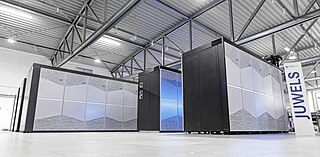
A quantum computer is a computer that takes advantage of quantum mechanical phenomena.

The Ames Research Center (ARC), also known as NASA Ames, is a major NASA research center at Moffett Federal Airfield in California's Silicon Valley. It was founded in 1939 as the second National Advisory Committee for Aeronautics (NACA) laboratory. That agency was dissolved and its assets and personnel transferred to the newly created National Aeronautics and Space Administration (NASA) on October 1, 1958. NASA Ames is named in honor of Joseph Sweetman Ames, a physicist and one of the founding members of NACA. At last estimate NASA Ames had over US$3 billion in capital equipment, 2,300 research personnel and a US$860 million annual budget.
Superconducting quantum computing is a branch of solid state quantum computing that implements superconducting electronic circuits using superconducting qubits as artificial atoms, or quantum dots. For superconducting qubits, the two logic states are the ground state and the excited state, denoted respectively. Research in superconducting quantum computing is conducted by companies such as Google, IBM, IMEC, BBN Technologies, Rigetti, and Intel. Many recently developed QPUs use superconducting architecture.
Microsoft Research (MSR) is the research subsidiary of Microsoft. It was created in 1991 by Richard Rashid, Bill Gates and Nathan Myhrvold with the intent to advance state-of-the-art computing and solve difficult world problems through technological innovation in collaboration with academic, government, and industry researchers. The Microsoft Research team has more than 1,000 computer scientists, physicists, engineers, and mathematicians, including Turing Award winners, Fields Medal winners, MacArthur Fellows, and Dijkstra Prize winners.

D-Wave Quantum Systems Inc. is a Canadian quantum computing company, based in Burnaby, British Columbia. D-Wave claims to be the world's first company to sell computers that exploit quantum effects in their operation. D-Wave's early customers include Lockheed Martin, University of Southern California, Google/NASA and Los Alamos National Lab.

Hartmut Neven is a scientist working in quantum computing, computer vision, robotics and computational neuroscience. He is best known for his work in face and object recognition and his contributions to quantum machine learning. He is currently Vice President of Engineering at Google where he is leading the Quantum Artificial Intelligence Lab which he founded in 2012.
Charles Tahan is a U.S. physicist specializing in condensed matter physics and quantum information science and technology. He currently serves as the Assistant Director for Quantum Information Science (QIS) and the Director of the National Quantum Coordination Office (NQCO) within the White House Office of Science and Technology Policy. Tahan is also Chief Scientist of the National Security Agency's Laboratory for Physical Sciences.

Andrew Yan-Tak Ng is a British-American computer scientist and technology entrepreneur focusing on machine learning and artificial intelligence (AI). Ng was a cofounder and head of Google Brain and was the former Chief Scientist at Baidu, building the company's Artificial Intelligence Group into a team of several thousand people.
Zachary John Dutton is an American physicist who has worked on research centred mainly around cold atomic gases, EIT, low light level nonlinear optics, quantum memories, and coherent optical. Dutton graduated from Lindsay High School in Lindsay CA, and was awarded a BSc in physics from UC Berkeley in 1996. He was awarded his PhD in theoretical physics at Harvard University in 2000. His doctoral advisor was Prof.Lene Hau for his thesis entitled "Ultra-slow, stopped, and compressed light in Bose–Einstein condensates" He worked on a number of papers with Hau and Cyrus Behroozi, being amongst the first group to stop light completely. He undertook postdoctoral work at NIST–Gaithersburg with Dr. Charles Clark, prior to becoming a staff physicist at the Naval Research Lab in Washington. He conducted research centred mainly around cold atomic gases, EIT, low light level nonlinear optics, quantum memories, and coherent optical storage.
D-Wave Two is the second commercially available quantum computer, and the successor to the first commercially available quantum computer, D-Wave One. Both computers were developed by Canadian company D-Wave Systems. The computers are not general purpose, but rather are designed for quantum annealing. Specifically, the computers are designed to use quantum annealing to solve a single type of problem known as quadratic unconstrained binary optimization. As of 2015, it was still debated whether large-scale entanglement takes place in D-Wave Two, and whether current or future generations of D-Wave computers will have any advantage over classical computers.
The USC-Lockheed Martin Quantum Computing Center (QCC) is a joint scientific research effort between Lockheed Martin Corporation and the University of Southern California (USC). The QCC is housed at the Information Sciences Institute (ISI), a computer science and engineering research unit of the USC Viterbi School of Engineering, and is jointly operated by ISI and Lockheed Martin.

Florian Neukart is an Austrian business executive, computer scientist, physicist, and scientific author known for his work in quantum computing and artificial intelligence. He has primarily been working on utilizing quantum computers, artificial intelligence, and related technologies for solving industry problems. In his work on artificial intelligence, he describes methods for interpreting signals in the human brain in combination with paradigms from artificial intelligence to create artificial conscious entities.
Cloud-based quantum computing is the invocation of quantum emulators, simulators or processors through the cloud. Increasingly, cloud services are being looked on as the method for providing access to quantum processing. Quantum computers achieve their massive computing power by initiating quantum physics into processing power and when users are allowed access to these quantum-powered computers through the internet it is known as quantum computing within the cloud.

Sycamore is a transmon superconducting quantum processor created by Google's Artificial Intelligence division. It has 53 qubits.
John M. Martinis is an American physicist and a professor of physics at the University of California, Santa Barbara. In 2014, the Google Quantum A.I. Lab announced that it had hired Martinis and his team in a multimillion dollar deal to build a quantum computer using superconducting qubits.

Sergio Boixo has degrees in computer engineering, philosophy, mathematics, and master and PhD in physics, and is best known for his work on quantum computing. He is currently working as Chief Scientist Quantum Computer Theory for Google's Quantum Artificial Intelligence Lab, a team he joined in 2013, shortly after its foundation.

JUWELS is a supercomputer developed by Atos and hosted by the Jülich Supercomputing Centre (JSC) of the Forschungszentrum Jülich. It is capable of a theoretical peak of 70.980 petaflops and it serves as the replacement of the now out-of-operation JUQUEEN supercomputer. JUWELS Booster Module was ranked as the seventh fastest supercomputer in the world at its debut on the November 2020 TOP500 list. The JUWELS Booster Module is part of a modular system architecture and a second Xeon based JUWELS Cluster Module ranked separately as the 44th fastest supercomputer in the world on the November 2020 TOP500 list.

Marissa Giustina is an American physicist who is a senior research scientist at the Quantum Artificial Intelligence Lab. Her research considers the development of quantum computing and experimental tests of quantum theory.









